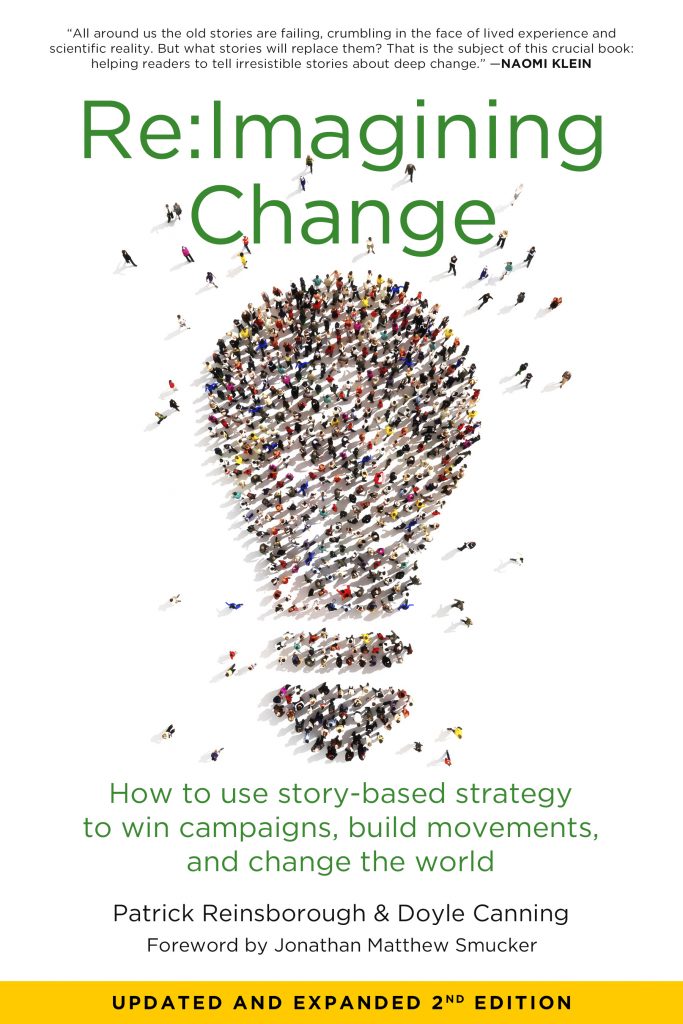
by Jason Harle and Michelle Stewart
Dark Matter in the ruins of imperial culture
August 31, 2011
Long-time activists Patrick Reinsborough and Doyle Canning have drawn from their wealth of practical contributions to successful and creative campaigns for ecological and social justice to craft the insightful and useful book, Re:Imagining Change.
Canning and Reinsborough are the co-directors of SmartMeme, a collective that helps grassroots organizations establish campaigns that are media savvy and develop through grassroots participation. Re:Imagining Change brings to life contemporary social theory by showing its application by both powerful interests and grassroots activists. Semiotics and hegemony are strategic approaches well-known in the corridors of the corporate public relations firms and public institutions that strategically shape public perceptions. The book aids students in using theoretical concepts to understand social change and helps activists adapt them to intervene in the production of social meaning around their principal sites of struggle.
The innovation of SmartMeme is narrative activism based upon a “story-based strategy.” At root, SmartMeme promotes a practical method of taking control of the language surrounding a socio-political issue, event, or campaign. Doyle and Reinsborough argue that there is more at stake in narrative-based political activism than “messaging” and “branding,” though these are powerful tools in the activist’s toolbox. Indeed, SmartMeme works via a holistic approach that includes a discourse analysis of both dominant groups and those groups working for social change, holding that “the power of story and storytelling has been at the center of social change efforts” (12) and at the heart of social control. In leading activists and students to perform this kind of analysis, Reinsborough and Canning are careful to point out that the issue is not simply one of facts or accuracy: “we often believe a story not necessarily because it is factually true; we accept a story as true because it connects with our values, or is relevant to our experiences in a way that is compelling” (20-1).
Thus, Reinsborough and Canning lead students to understand the creation and dissemination of cultural meaning beyond the news industry’s battered standard of objectivity. Rather than hitting our heads against the wall trying to understand the media traction of recent canards like the health care bill’s alleged “death panels” and the media myth most impervious to documented truth, the real birthplace of President Obama, Reinsborough and Canning show how essential it is to understand the staying power of the well-crafted story that resonates with pre-existing habits of thought. The significance of their narrative-based activism lies in its ability to encourage self-examination of mainstream stories and those of left-wing/grassroots groups, those stories lived as real and coherent, stories that organize movements and counter-responses.
On a practical level, with careful analysis and great in-the-trenches examples from current grassroots political campaigns, Reinsborough and Canning elucidate and update Gramsci’s theory of hegemony, Gene Sharp’s “consent theory of power,” and Foucault’s notion of how discourse conditions the terms and limits of political action. As such, this book is a great addition to a communication and cultural studies curriculum that includes Goffman’s work on framing and Lakoff’s linguistic analyses of political discourse, as well as any course exploring the workings of political media in the contemporary society of the spectacle. We are not dupes, but we are sidelined from meaningful political action if we fail to understand the “control mythologies,” the narratives disseminated by those holding power. And, we must then intervene at the level of the emotional hold of the story – we can’t merely “speak truth to power” anymore. Instead, Reinsborough and Canning’s strategies promote a “narrative power analysis” that challenges hidden assumptions, the resistance encouraged by what people already believe they know (27). Change agents must examine their own “narrative filters” and identify the crucial “points of intervention,” the moments of weakness in control narratives where creative activists can “challenge, change, and/or insert a new story” (28).
Reinsborough and Canning also offer a useful model for an analysis of the efficacy of marketing campaigns, showing how branding diffuses corporate self-image and how successful cultural jamming can intervene in such messaging in order to promote awareness and social change. Likewise, they challenge the control-memes of power-holders, deconstructing the story elements of dominant narratives: “Conflict, Characters, Imagery (Show, Don’t Tell), Foreshadowing, and Assumptions.” By leading activists and students to analyze these elements and by highlighting the centrality of timing, targeting and addressing intended audiences, Reinsborough and Canning show how the framing of discourse is much more elaborate, subtle, and powerful than mere messaging or sloganeering. As they argue, “We believe framing is an important concept because it is fundamentally about the issue of power in the story.
Story-based strategy explores who does and does not have power in the story, with the aim of shifting power in the story. This interplay of power and representation is the essence of framing and reframing” (49). Moreover, through useful exercises and discussion questions, the authors encourage students and activists to apply insights from the book to other campaigns and to develop communication strategies collectively.
Reinsborough and Canning provide several contemporary examples of the setting of both dominant frames and successful counter-campaigns to shift the frame to reveal where power has selectively or manipulatively directed our attention. One particularly potent example contrasts the CNN images of the famous toppling of the statue of Saddam Hussein in 2003 with Reuters photographs of the same event that show the small crowd of Iraqis dwarfed by US tanks. The lesson here is two-pronged, highlighting the powerful symbolism of popular citizen action and the power relations that may condition such actions and their representation.
Other examples highlight creative campaigns for brand-busting, for derailing control memes, and of “repurposing popular culture narratives,” for example, the “selling of the World Bank on eBay.” The culture-jamming logic of the campaign drew on critiques of the functioning of the World Bank, pointing to the low-wages of sweatshops and diffusing the message via spectacular headlines, such as, “World Bank for sale on eBay – Activists say the bank ‘will do a lot less harm to the world gathering dust in your attic’ (CNN)” (77). By identifying the most effective points of intervention – the points of production, of consumption, of destruction, of decision-making, and of assumption, Reinsborough and Canning argue that activists can most successfully frame new narratives, unravel control mythologies, and, fundamentally “change the story” to promote new visions of the future from the bottom up.
Re:Imagining Change balances techniques for incisive, “deconstructive” critical analysis with “constructive methods” for building resonate narratives and successful campaign actions. Reinsborough and Canning’s comprehensive “Story-based Strategy Campaign Model” can be a useful guide and source of optimistic inspiration for 21st century grassroots activists. Finally, Re:Imagining Change can serve as a powerful classroom tool for communications studies, cultural studies, sociology and political science, elucidating complex arguments about social power with great clarity and concrete, poignant examples.






